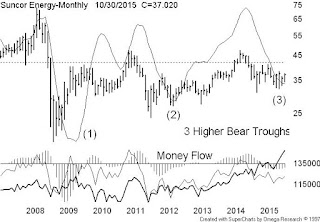Join
me and Kevin Prins, Director of National Sales - BMO ETFs - at the Toronto
World MoneyShow Friday, October 30 at 1:30 pm as we discus ETFs and how they
can be selected to use natural sector rotation as a tool to move in and out of global
markets
Sector
selection takes advantage of natural stock market rotation due to the normal
business cycle which is led by the consumer followed by manufacturing and
finally the cyclical industries. When executed properly rotation allows you to
remain fully invested by over-weighting in the rising sectors and
under-weighting in the falling sectors.
If
you wish to adopt this strategy the first step is to recognise the 10 unique
and distinct stock sectors (or asset classes) as set out by the index people at
Standard & Poor's. They are Energy, Materials, Industrials, Consumer
Discretionary, Consumer Staples, Health Care, Financials, Information
Technology, Telecommunications Services and Utilities
The
best way to understand the rotation order is to picture a 10-car roller coaster
with the financial, utility and consumer sectors riding in the front two or
three cars. We call this the front end of the market. The next three or four cars will be occupied
by the telecom, technology and industrial sectors. We refer to these as the
middle of the market - and finally riding in the last few cars would be the
energy and materials group which we refer to as the back end of the market.
Picture
now this 10-car train slowly climbing to the crest of the ride (a bull market)
and eventually the front end slipping over the crest and now falling. So now we
have a condition with occupants in the front end screaming in fear while the
middle and back end cars still are enjoying the climb. Eventually the middle
cars crest and you know the rest.
The global markets also are also driven by the forces
of rotation – our chart displays the lead – lag relationship between the BMO (ZUH)
and the BMO (ZEO)








